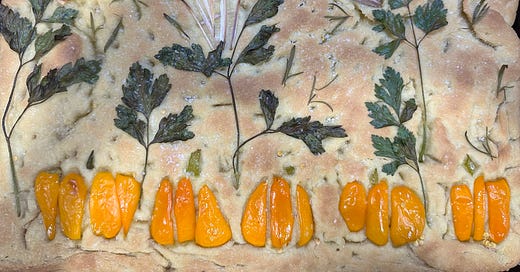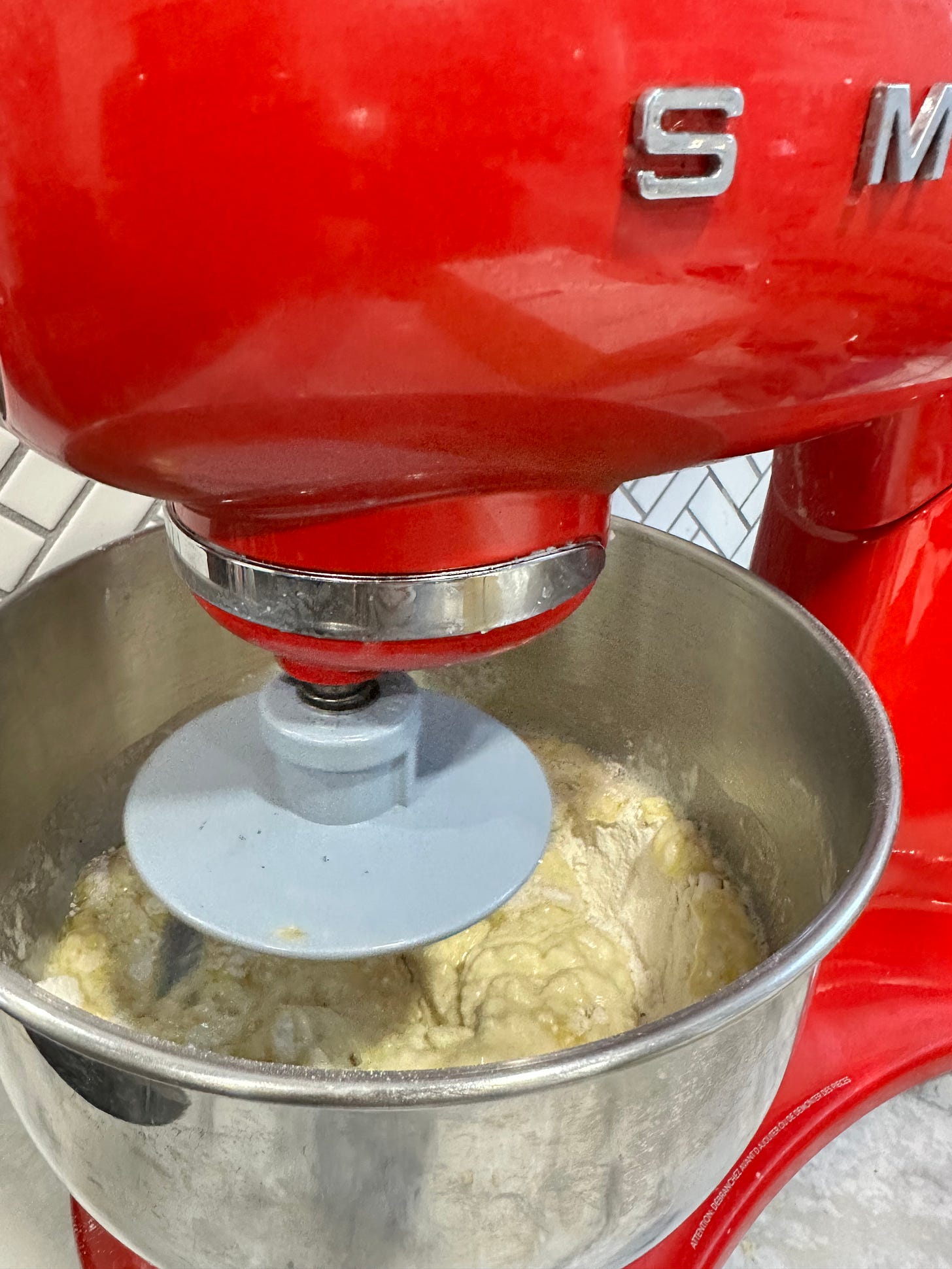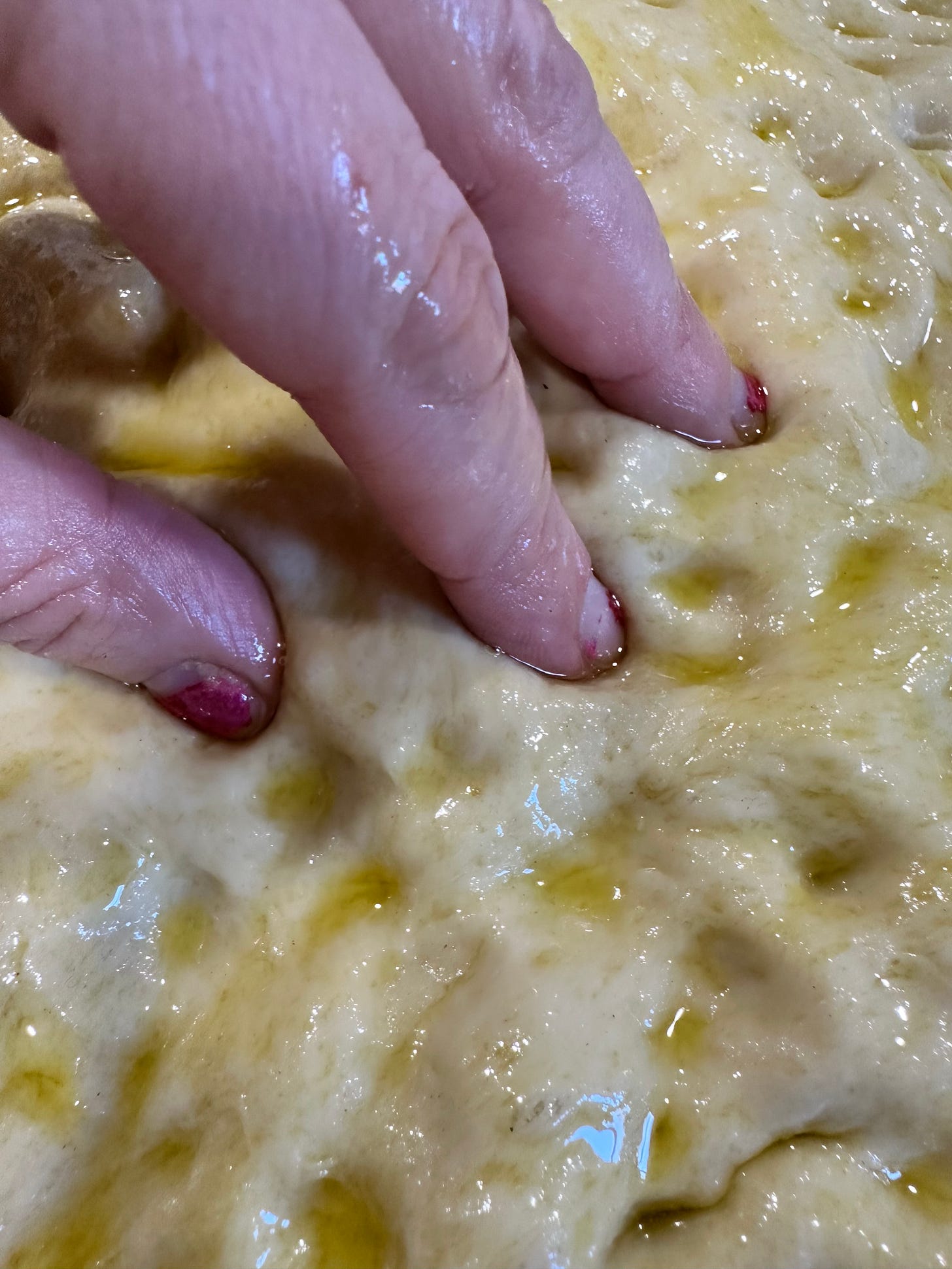I love making Italian food, but I don’t love making Italian bread. Unfortunately, I’ve had to up my game since moving to the South, since no one here seems to have ever met an Italian before me.
But given that I do have a full-time job, plus full-time children, I’ve had to come up with something to go with spaghetti and meatballs that doesn’t take a ton of effort — and focaccia is simple, delicious, and can be left by itself for much of the day between 15-20 minute spurts of interest. You can also dress it up or down, and although I love to put adorable designs on my focaccia, I’m not going to pretend that anyone other than me eats bread that some deranged woman has defaced with vegetables.
This time around, though, I’m using an old photo of completed focaccia (yes! someone on the internet is lying to you!) because my preferred method of proofing in the wintertime forces me to play with fire: I like to heat the oven to about 150 to 170 degrees F, then shut the oven off, open the door for a few minutes, and place my dough inside to proof, leaving the oven door cracked at the top so that air can circulate.
Now, this shouldn’t cause immediate failure (in fact, its a great idea). But my children have been taught to close the oven door when it’s been left open. Except this time I wanted the oven door open. Dutiful as never, they shut the oven door and the dough got dried out and gummy. The focaccia still tasted fine but lacked a certain aesthetic value and the chickens got a surprise treat.
Anyway, here’s the best focaccia recipe I’ve found, and all you need is flour, sugar, water, yeast, olive oil, and salt.
Homestyle Focaccia
1 3/4 cups of warm water
2 1/4 tsp (or 1 package) of active dry yeast
1 TBSP sugar
625g (5 cups) of all-purpose flour
1 TBSP Kosher salt
1 cup of extra virgin olive oil (use the good stuff)
Bloom your yeast by dropping it into the warm (not hot!) water along with the sugar. Leave the mixture in a warm spot for about 15 minutes until the yeast is bubbling and it smells faintly of baking bread.
Get out your stand mixer (one that likes to knead bread, not the Smeg as pictured, which prefers not to mix anything), outfit it with the dough hook, and add the flour and salt to the bowl. Slowly mix in half of the olive oil (so 1/2 cup) along with the yeast mixture until the resulting mixture starts to look like bread dough. At that point, move the mixer’s speed to medium and continue to knead your dough for about 5-6 minutes.
If your mixer is like mine and occasionally gives up, once the dough comes together, you can pull the dough out and knead it on the countertop. Be sure to use plenty of flour on your counters and hands so that the dough doesn’t stick to everything.
Once you’ve given the dough a good 5 minutes of kneading, drop it out onto the counter and knead it by hand once or twice, enough to form a smooth round ball. Coat the inside of a large bowl with olive oil, drop the dough ball into the bowl and move it around so it’s also coated in the oil. Cover with a towel and place in a warm location for about an hour.
(Obviously, if you have no obedeient children, you can try to use the oven method I described above, otherwise any warm, dry place is fine, preferably somewhere that is a bit warmer than room temperature)
Now, coat a jelly roll pan (or a cookie sheet with sides) in the remaining 1/2 cup of olive oil. Drop the ball of dough into the jelly roll pan and smush the dough out to the edges of the pan. You should have enough dough to make it nearly the size of the pan, but don’t worry if you don’t make it all the way. You still have one more rise.
Using your fingertips, make finger holes all across the surface of the dough. Try to smush your fingers all the way through the dough to the bottom without creating holes in the dough. Although it is immensely tempting, DO NOT subsequently pick your fingers up and make a “bloop, bloop” noise — this will cause peaks in the dough next to your valleys and it won’t quite look right.
Put the jelly roll pan with the dough in a warm spot to rise a second time, about an hour. Preheat your oven to 425F.
Now, you can either sprinkle the dough with Kosher salt for a plain focaccia that’s ideal for serving with a plate of pasta or for making a sandwich, OR you can get creative. There’s really no limit to what you can put on a focaccia, though rosemary, red onions, olives, and sundried tomatoes are personal favorites. You can also dress the focaccia like a pizza, but bear in mind, baking time may be longer.
Once you’ve exhausted your artistry, put the focaccia in the oven for 25-30 minutes, until its golden brown or, if you’ve made a pizza, the cheese is crisp and bubbly.







